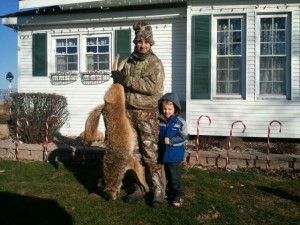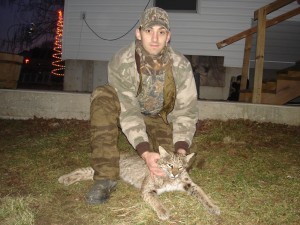Coyote Hunting
After having many requests for info on calling coyotes I thought I’d oblige and try and share some info. I’ll be the first to admit that my expertise is in all things deer, turkey and waterfowl and that predator hunting is still something that I’m learning. That being said, I’ve called in bobcat, coyotes and foxes using the techniques I’ll share with you.
The first thing you want to realize is that a coyote has some of the best senses and wit of just about any animal you will hunt. They see, smell and hear extremely well and they don’t seem to forget much either! They have a survival instinct like no other.
1. I believe that the most common mistake is being sloppy getting to your set-up spot. Sneak to your setup spot as much as possible. If that coyote sees you walk in and start calling 5min later he does not forget that it was you, not a squealing rabbit he saw walk into the brush pile. Full camo is also a must. Coyotes generally don’t just lock up when they see movement or something out of place, they usually bolt and a sprinting coyote is NOT an easy target!
2. We all know it’s important to get the wind right while deer hunting but I’m here to tell you that this is just as important with coyotes. It’s best (although not always possible) to have shooting lanes down wind of you, as many times coyotes will circle downwind of the squealing.
3. Coyote hunting can seem 2nd rate hunting, not worth gettin up early for, but if that’s the attitude, expect to waste a lot of time. As for deer, movement is greatest for coyotes in the mornings and in the evenings.
4. We all get hung up on calling, and I do believe that good calling is important, but probably not as important as the above 3 points. I don’t know if you’ve ever heard a rabbit in true distress, but it’s not pretty and there really is no rhyme or rhythm to the screeching. Get the pitch right, make it quiver and slide and basically just sound as agonizing as possible! My favorite distress call is the primos Catnip. This call is incredibly easy as it does not have an open reed although it retains its versatility simply by biting the flexible mouthpiece. This is the call I’ve called in a bobcat with and makes some great cat growling if you want to target bobcats. The other distresss call I use is called “tweety” and it is made by verminator. It is an open reed call that I can get a bit more volume out of and is a different tone that I like to mix in with the catnip.
I also like the primos mini howler. I’m still learning what howls to use when, but I can nail all the sounds with this one call. This call is fun at night just playing with packs of coyotes, and helps in learning how to sound as well.
I’m posting a video along with this post that will be most instructive on calling and will hopefully re-inforce much of what I’m saying here just not quite as in-depth.

